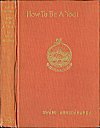How to be a Yogi
 |
Preface |
|
THE Vedânta Philosophy includes the different branches of the Science of Yoga. Four of these have already been treated at length by the Swâmi Vivekananda in his works on "Râja Yoga," "Karma Yoga," "Bhakti Yoga," and "Jnâna Yoga"; but there existed no short and consecutive survey of the science as a whole. It is to meet this need that the present volume has been written. In an introductory chapter are set forth the true province of religion and the full significance of the word "spirituality" as it is understood in India. Next follows a comprehensive definition of the term "Yoga," with short chapters on each of the five paths to which it is applied, and their respective practices. An exhaustive exposition of the Science of Breathing and its bearing on the highest spiritual development shows the fundamental physiological principles on which the whole training of Yoga is based; while a concluding chapter, under the title "Was Christ a Yogi?" makes plain the direct relation existing between the lofty teachings of Vedânta and the religious faiths of the West. An effort has been made, so far as possible, to keep the text free from technical and Sanskrit terms; and the work should therefore prove of equal value to the student of Oriental thought and to the general reader as yet unfamiliar with this, one of the greatest philosophical systems of the world. THE EDITOR. Next > > |
- www.vivekananda.net edited by Frank Parlato Jr.